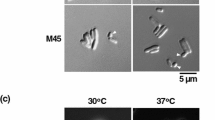Abstract
Azospirillum brasilense swims in liquid environments and swarms in semisolid media. Five variants of A. brasilense Sp245, Sp245.P1–Sp245.P5, which swarmed faster than Sp245 in a semisolid malate–salt medium, have been isolated. In Sp245.P1–Sp245.P4, a new megaplasmid was revealed instead of an indigenous 85-MDa plasmid (p85). By polymerase chain reactions (PCR) with primers to the segments of p85 important for proper bacterial motility/flagellation and for dissimilatory nitrite and NO reduction, that DNA of p85 was found retained by all the variants. In ERIC- and RAPD-PCR, microdiversity between the total DNAs of Sp245 and its variants was detected. Interstrain differences in growth characteristics in liquid peptone–succinate–salt medium with KNO3 or KNO2 and in KNO2 production/consumption were revealed. Although all the variants swam and swarmed faster than Sp245 in the medium supplemented with NH4Cl or KNO3, not all of them could do so in MPSS with KNO2.




Similar content being viewed by others
References
Baldani VLD, Baldani JI, Döbereiner J (1983) Effects of Azospirillum inoculation on root infection and nitrogen incorporation in wheat. Can J Microbiol 29:924–929. doi:10.1139/m83-148
Barassi CA, Sueldo RJ, Creus CM, Carrozzi LE, Casanovas EM, Pereyra MA (2007) Azospirillum spp., a dynamic soil bacterium favourable to vegetable crop production. Dyn Soil Dyn Plant 1:68–82
De Bruijn FJ (1992) Use of repetitive (repetitive extragenic palindromic and enterobacterial repetitive intergeneric consensus) sequences and the polymerase chain reaction to fingerprint the genomes of Rhizobium meliloti isolates and other soil bacteria. Appl Environ Microbiol 58:2180–2187
Eckhardt T (1978) A rapid method for the identification of plasmid deoxyribonucleic acid in bacteria. Plasmid 1:584–588. doi:10.1016/0147-619X(78)90016-1
Fancelli S, Castaldini M, Ceccherini MT, Di Serio C, Fani R, Gallori E, Marangolo M, Miclaus N, Bazzicalupo M (1998) Use of random amplified polymorphic DNA markers for the detection of Azospirillum strains in soil microcosms. Appl Microbiol Biotechnol 49:221–225. doi:10.1007/s002530051162
Gerhardt P, Murray RGE, Wood WA, Krieg NR (1994) Methods for general and molecular bacteriology. Am Soc Microbiol, Washington
Hall PG, Krieg NR (1983) Swarming of Azospirillum brasilense on solid media. Can J Microbiol 29:1592–1594. doi:10.1139/m83-243
Katsy EI, Borisov IV, Petrova LP, Matora LY (2002) The use of fragments of the 85- and 120-MDa plasmids of Azospirillum brasilense Sp245 to study the plasmid rearrangement in this bacterium and to search for homologous sequences in plasmids of Azospirillum brasilense Sp7. Russ J Genet 38:24–131. doi:10.1023/A:1014373725254
Katzy EI, Borisov IV, Scheludko AV (2001) Effect of the integration of vector pJFF350 into plasmid 85-MDa of Azospirillum brasilense Sp245 on bacterial flagellation and motility. Russ J Genet 37:129–134. doi:10.1023/A:1009081603530
Kovtunov EA, Shelud’ko AV, Katsy EI (2012) Alterations in the primary structure of an 85-MDa plasmid affecting flagellation and motility of the bacterium Azospirillum brasilense Sp245. Russ J Genet 48:125–128. doi:10.1134/S1022795412010115
Martin-Didonet CCG, Chubatsu LS, Souza EM, Kleina M, Rego FGM, Rigo LU, Yates MG, Pedrosa FO (2000) Genome structure of the genus Azospirillum. J Bacteriol 182:4113–4116. doi:10.1128/JB.182.14.4113-4116.2000
Molina-Favero C, Creus CM, Simontacchi M, Puntarulo S, Lamattina L (2008) Aerobic nitric oxide production by Azospirillum brasilense Sp245 and its influence on root architecture in tomato. Mol Plant Microbe Interact 21:1001–1009. doi:10.1094/MPMI-21-7-1001
Nicholas DJD, Nason A (1957) Determination of nitrate and nitrite. In: Colowick SP, Kaplan NO (eds) Methods in enzymology, vol 3. Academic Press, New York, pp 981–984
Petrova LP, Borisov IV, Katsy EI (2005) Plasmid rearrangements in Azospirillum brasilense. Microbiology 74:495–497. doi:10.1007/s11021-005-0094-8
Petrova LP, Shelud’ko AV, Katsy EI (2010) Plasmid rearrangements and alterations in Azospirillum brasilense biofilm formation. Microbiology 79:121–124. doi:10.1134/S0026261710010169
Petrova LP, Varshalomidze OE, Shelud’ko AV, Katsy EI (2010) Localization of denitrification genes in plasmid DNA of bacteria Azospirillum brasilense. Russ J Genet 46:801–807. doi:10.1134/S1022795410070045
Pothier JF, Prigent-Combaret C, Haurat J, Moënne-Loccoz Y, Wisniewski-Dyé F (2008) Duplication of plasmid-borne nitrite reductase gene nirK in the wheat-associated plant growth–promoting rhizobacterium Azospirillum brasilense Sp245. Mol Plant Microbe Interact 21:831–842. doi:10.1094/MPMI-21-6-0831
Rademaker JLW, Louws FJ, de Bruijn FJ (1998) Characterization of the diversity of ecologically important microbes by rep-PCR fingerprinting. In: Akkermans ADL, van Elsas JD, de Bruijn FJ (eds) Molecular microbial ecology manual, suppl 3. Kluwer, Dordrecht, pp 1–26
Shelud’ko AV, Borisov IV, Krestinenko AV, Panasenko VI, Katsy EI (2006) Effect of congo red on the motility of the bacterium Azospirillum brasilense. Microbiology 75:48–54. doi:10.1134/S0026261706010103
Shelud’ko AV, Ponomareva EG, Varshalomidze OE, Vetchinkina EP, Katsy EI, Nikitina VE (2009) Hemagglutinating activity and motility of the bacterium Azospirillum brasilense in the presence of various nitrogen sources. Microbiology 78:696–702. doi:10.1134/S0026261709060058
Shelud’ko AV, Varshalomidze OE, Petrova LP, Katsy EI (2011) Effect of genomic rearrangement on heavy metal tolerance in the plant-growth-promoting rhizobacterium Azospirillum brasilense Sp245. Folia Microbiol. doi:10.1007/s12223-011-0074-5
Steenhoudt O, Keijers V, Okon Y, Vanderleyden J (2001) Identification and characterization of a periplasmic nitrate reductase in Azospirillum brasilense Sp245. Arch Microbiol 175:344–352. doi:10.1007/s002030100271
Vial L, Lavire C, Mavingui P, Blaha D, Haurat J, Moënne-Loccoz Y, Bally R, Wisniewski-Dyé F (2006) Phase variation and genomic architecture changes in Azospirillum. J Bacteriol 188:5364–5373. doi:10.1128/JB.00521-06
Author information
Authors and Affiliations
Corresponding author
Rights and permissions
About this article
Cite this article
Varshalomidze, O.E., Petrova, L.P., Shelud’ko, A.V. et al. Spontaneous Super-Swarming Derivatives of Azospirillum brasilense Sp245 have Different DNA Profiles and Behavior in the Presence of Various Nitrogen Sources. Indian J Microbiol 52, 689–694 (2012). https://doi.org/10.1007/s12088-012-0315-6
Received:
Accepted:
Published:
Issue Date:
DOI: https://doi.org/10.1007/s12088-012-0315-6




